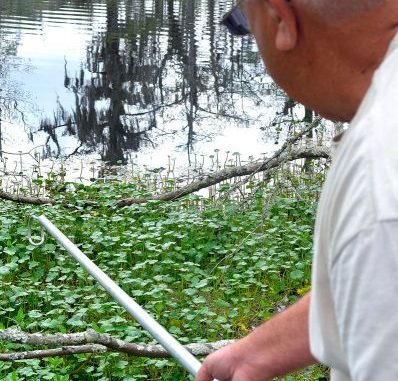
If sac-a-lait are off points, Fontenot motors over to hyacinth mats and other grass patches and use a homemade, pronged aluminum rake to make holes in the mats about 12 inches in diameter.
He uses Uncle Buck’s or Mister Crappie poles to drop baits into those holes in the vegetation.
For fishing vertically, Fontenot favors Mister Crappie reels with 8- to 15-pound Stren or Trilene. He often uses gold or orange monofilament so he can see his line and better detect subtle bites.
Despite the noise and disturbance caused by raking holes in the vegetation, fish will often be caught during the first drop of a jig.
Surprisingly, anglers also can catch bass this way, but mostly as a bycatch.
In addition to his Jenny’s Jigs hair jigs, Fontenot will also use tube jigs by Midsouth Tackle and H&H Lures’ solid-body, crappie tube jigs.
He sticks with 1/16- or 1/32-ounce jigheads.
“I have taken up to 20 crappie on a single H&H Lures’ solid-body, black/chartreuse tube jig,” Fontenot said. “So when I use tube jigs, I’m kind of partial to those.”
Lavergne is a light-tackle specialist, using Apache Tomahawk fly rods equipped with Pfleuger Underspin reels.
When vertically jigging through foliage, Lavergne uses an 8-foot, 6-inch Apache Tomahawk with his plastics on 1/16- or 1/32-ounce jigheads attached to his line with a loop.
Lavergne prefers blue/white and solid-chartreuse tube jigs and Egret Baits’ Wedgetail Crappie Minnows under the grass mats of alligator grass, hyacinths and pennywort.